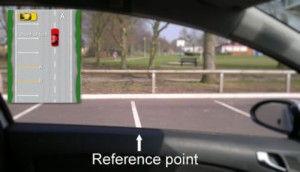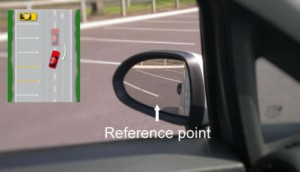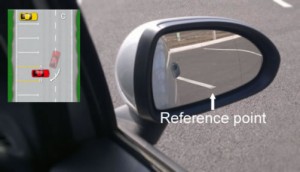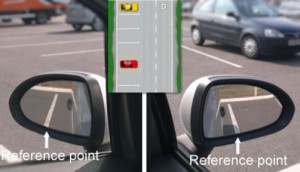This guide is to help successfully complete the ‘reversing into a bay’ bay parking manoeuvre and should be used alongside the bay parking tutorial.
An alternative manoeuvre for the new driving test is forward parking into a bay and reversing out, in which there is a separate tutorial.
The bay parking manoeuvre can be difficult, so to make all manoeuvres as easy as possible, it’s important to use reference points. Reference points are essentially ‘markers’ that are used throughout the manoeuvre. With constant practice, the bay parking reference points will become easy to find and to remember.
There are several techniques that can be used for teaching the bay parking manoeuvre, we have found that this technique is one of the easiest.
This bay parking reference points tutorial should be used alongside the bay parking manoeuvre tutorial as an aid to establishing reference points.

Bay parking reference point A
As you pull alongside the bays to the point of turn, as suggested in diagram A in the bay parking tutorial, the point of turn line will need to be lined up in the centre of the passenger side door. When you steer full left lock, it will guide you into the 3rd bay from this line. This reference point may need to be altered slightly for different makes of cars. Reference point A is the most important reference point in bay parking manoeuvre. If this initial reference point is not accurate, the entire manoeuvre is not likely to succeed.

Bay parking reference point B
As you begin to reverse of full left steering lock, you will see line A (the line to the left of your bay) start to appear in the left wing mirror.
Keeping a check on this will allow you to establish that you are going into the bay correctly. Sit upright to get the best possible view of this reference point whilst reversing.

Bay parking reference point C
A little later as you are reversing on full left steering lock, Line B (the line to the right of your bay) will appear in the right wing mirror.
Again, sit upright to gain the best view and keep checking between the lines of reference point B and C.

Bay parking reference point D
You will know when the car is straight because both lines in both wing mirrors will be parallel to your car as in the picture. As soon as they become parallel, ensure you briskly straighten the steering wheel. To know how far you should go back before stopping, you can use the junction line reference point as a guide. Using the junction lines reference point will put you sufficiently back in the bay without fear of hitting the kerb or wall at the rear. If there is no line joining the individual bay lines, imagine where it would be and use that.
LEarning Bay parking tips
Along with using reference points for the bay parking manoeuvre, here are some key tips to help you succeed:
- Keep the car extremely slow
- Constantly check reference points
- Constantly look all around for approaching vehicles or pedestrians and stop if necessary
- If you feel the manoeuvre is going wrong, pull forward and and try again
- If the manoeuvre did not finish correctly, ask if you can try again
Bay parking reference points
The bay parking reference points used may need altering slightly depending on the make and model of the car used, although they should remain similar. In this particular exercise, the reference points are based on a Vauxhall Corsa.
Additional Information
For tutorials on all test manoeuvres, see:

hiya I just finished work and I have a mock test tomorrow. im abiit tired and my minds gone blank. I was wondering if the bay is on the right do you stir to the right . Ive totally forgotton lol
Hello Christina,
Yes, you steer to the right id the bay is on the right and steer to the left if the bay is on the left 🙂
Greetings!
while ready to revease into the bay , if the bay is at the left side, which way will i stare the wheel, at the right or at the left in full lock?
Hi Benito,
If the bay is on your left, steer full left lock, if it’s on your right, steer full right lock. Make sure you can see the bay lines in your door mirrors so you can see where they are. You can lower the mirrors if necessary, but don’t forget to readjust them before driving off.
Hi which blind spot do i need to make sure I check if I am reversing into the right bay?
Hi Tegan,
You need effective ‘all round’ observation. So you’ll need to keep the car very slow and check both blind spots. By checking over your right shoulder into the right-side blind spot, you’ll be able to see in the area where the rear of your car is moving. But because the front of your car will be swinging around to the left when reversing to the right, you’ll also need to keep a check on the left blind spot. There’s a lot of observations to do, but provided you keep your car super-slow, it’s easy to fit it all in.